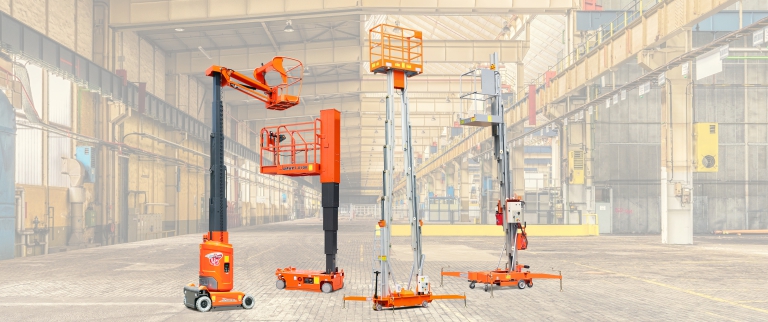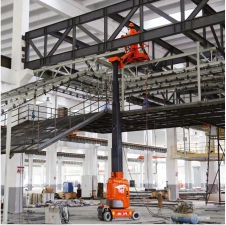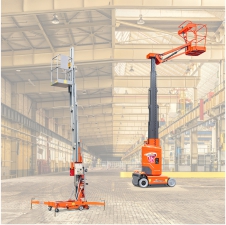November 05,2024
How Vertical Lifts Can Maximize Efficiency on Your Jobsite

Vertical lifts are essential in many industries to enhance productivity and safety at work sites. These devices are designed to transport workers and materials vertically to higher elevations, making them ideal for construction, maintenance, warehousing, and more tasks. Vertical lift solutions, such as push-around vertical mast lifts, self-propelled vertical mast lifts, hydraulic vertical lifts, and electric vertical lifts, come in various configurations to meet different job requirements. In this blog, we'll explore what a vertical lift is, the types available, and how it can significantly improve worksite efficiency.

Understanding Vertical Lifts
A vertical lift is a mechanical device that raises personnel or materials vertically to reach elevated work areas. These lifts are designed to improve access to high places, ensuring tasks are performed quickly and safely. Vertical lift systems can be operated manually or electrically, and their compact size makes them suitable for tight spaces where traditional scaffolding may not fit. The primary types of vertical lifts include:
- Push-around Vertical Mast Lift: A manually positioned lift used for smaller tasks where mobility is critical.
- Self-Propelled Vertical Mast Lift: Equipped with motorized capabilities for easy navigation across job sites.
- Hydraulic Vertical Lift: Hydraulic power elevates, providing stable and smooth lifting for heavier tasks.
- Electric Vertical Lift: Runs on electric power, offering quieter operation and lower maintenance.
How Vertical Lifts Improve Worksite Efficiency
Vertical lifts are valuable worksite assets because they streamline tasks and boost productivity. Here are the ways vertical lift solutions can improve worksite efficiency:
1. Enhanced Accessibility
- Vertical platform lifts allow workers to access inaccessible areas with ladders or scaffolding.
- It is ideal for electrical work, painting, or equipment installation at elevated positions.
2. Time-Saving Operations
- With a vertical lift system, workers can quickly reach the required height, reducing the time spent on manual climbing.
- Self-propelled vertical mast lifts enable swift movement between work areas, minimizing downtime.
3. Improved Safety
- Vertical lifts have safety features such as guardrails and fall protection systems to reduce the risk of accidents.
- It provides a stable working platform, especially when compared to ladders, minimizing the chances of falls.
4. Versatility Across Different Worksites
- Suitable for various environments, including construction sites, warehouses, and factories.
- They can be used indoors and outdoors, making them adaptable for multiple tasks.
5. Cost-Effective Solutions
- Vertical lift rental options provide a cost-effective solution for short-term projects without a significant upfront investment.
- Companies looking for long-term usage can explore vertical lift for sale, offering a durable and reliable lifting solution.

Types of Vertical Lifts Explained
Vertical lifts come in different types to meet specific requirements at worksites. Here's an in-depth look at the most common options:
1. Push-Around Vertical Mast Lift
- Manual Positioning: Requires the operator to position the lift manually.
- Ideal for Smaller Jobs: Suitable for indoor maintenance tasks such as lighting repairs or ceiling installations.
- Compact Design: Its small footprint allows it to fit through standard doorways and narrow aisles.
2. Self-Propelled Vertical Mast Lift
- Motorized Navigation: Comes with controls for easy movement, allowing operators to relocate the lift without dismounting.
- Suitable for Larger Worksites: This is perfect for tasks that require frequent repositioning, such as in warehouses or large industrial facilities.
- Enhanced Stability: Provides a stable platform even on uneven surfaces.
3. Hydraulic Vertical Lift
- Smooth Operation: Uses hydraulic pressure to provide a controlled and smooth lift.
- Heavy-Duty Applications: Suitable for outdoor construction projects or tasks involving heavy materials.
- Maintenance Considerations: Regular inspection of hydraulic systems is required to ensure optimal performance.
4. Electric Vertical Lift
- Energy-Efficient: Runs on electric power, offering a sustainable lifting solution.
- Low Noise Level: Ideal for indoor environments such as offices, hospitals, or retail stores.
- Minimal Maintenance: Fewer mechanical components reduce the frequency of repairs and maintenance.
Key Benefits of Using Vertical Lifts
Using vertical lift systems at worksites brings numerous benefits, including:
- Increased Productivity: Workers can reach elevated positions quickly and safely, allowing tasks to be completed more efficiently.
- Enhanced Safety Standards: Built-in safety features and stable platforms ensure worker safety at height.
- Adaptability to Various Tasks: Vertical lifts are versatile tools for multiple industries, from routine maintenance to construction projects.
- Reduction in Physical Strain: Lifting workers and materials mechanically reduces the risk of injury associated with manual climbing or lifting.
Factors to Consider When Choosing a Vertical Lift
To select the right vertical lift for your worksite, consider the following factors:
1. Height Requirements
Determine the maximum height you need to reach. Hydraulic and self-propelled lifts can often accommodate greater heights.
2. Weight Capacity
Consider the weight of personnel and materials that need to be lifted. Choose a lift that can safely support the load.
3. Mobility Needs
For worksites with frequent movement, self-propelled lifts offer better manoeuvrability. Push-around lifts are suitable for stationary tasks.
4. Indoor vs. Outdoor Use
Electric lifts are quieter and cleaner, making them ideal for indoor use, while hydraulic lifts perform better in rugged outdoor environments.
5. Budget Considerations
If the need is temporary, renting a vertical lift is a cost-effective option. Investing in a vertical lift for sale may be more economical for long-term projects.
Conclusion
Vertical lifts are vital for enhancing worksite efficiency by providing a safe and quick means of accessing elevated areas. Whether opting for a push-around vertical mast lift for smaller tasks or a self-propelled vertical mast lift for larger projects, these lifts offer valuable benefits across various industries. With options like hydraulic vertical lifts and electric vertical lifts, companies can find suitable vertical lift solutions to meet their unique needs. Whether you want a vertical lift for sale or prefer rental options, incorporating the right vertical lift system can significantly improve productivity, safety, and cost-effectiveness at your worksite.